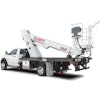
Deciding how to tackle landscaping jobs, no matter what time of year, can be tough. Several types of rake attachments are available and, depending on your customers’ job requirements, each offers specific benefits. By better understanding the different types of rake attachments available and the value of each, you can properly stock your rental fleet and help your customers evaluate their job requirements and soil conditions to determine which is best for their needs.
Site Cleanup
When starting a landscape project, your customers first need to create manageable soil if it isn’t already present. Grader rake attachments feature strong, evenly spaced tines designed to separate debris for site cleanup and scarify and level compacted soils.
Grader rakes are best for applications that require the clearing of coarse materials such as sticks, bricks, rocks and roots on a jobsite. It is not recommended for preparing soil for grass seeding because its tines create long striations that allow seed to fall too far into the ground, creating stripes in a lawn, a landscaping faux pas.
Grader rakes can typically be adjusted to better suit specific tasks. For instance, using the attachment for rough leveling or scarification may require a different rake angle or attachment to the wheel arm than if your customers are using it to push large quantities of loose material. Discuss job requirements with your customers so you can give them useful advice on how to adjust the grader rake they will be renting and tell them to carefully read the operator’s manual for the proper positioning for each task.
Soil Preparation
Once excess debris has been cleared away from the jobsite and the ground has been leveled to the appropriate grade, soil can be prepared for seeding. Auto rakes utilize a bucket with either a rake chain or a bar with teeth on it to remove smaller rocks and debris from loose soil and sift the surface layer of the soil to effectively groom and finish it for seed or sod. Unlike the grader rake, an auto rake can collect, transport and dump debris quickly and easily.
Remind customers that before using an auto rake attachment, they should check to see that the area is free of all boulders larger than roughly six inches in diameter, logs and large tree branches, wire, lumber and any other item that is too large for the bucket or could get wrapped around the rake chain. It is also important to make sure the soil is relatively loose and that any compacted areas have been tilled with another piece of equipment to a depth of two inches or deeper. If your customers are attempting to pick up large debris with an auto rake attachment or using it to till compacted soil, they could severely damage the attachment and lessen your profitability.
The Triple Threat
A preparator rake attachment can be a customer’s best friend in soil preparation and a great addition to your rental fleet. This one attachment combines the cleanup, rock removal and soil preparation capabilities of the grader rake and auto rake into one easy-to-maneuver rake attachment. Its rotating bi-directional drum carries rocks and debris into the perforated bucket, which efficiently sifts dirt to till and fluff the ground as it grooms the soil.
Recommend a preparator rake for the following tasks without switching between attachments:
- Rock Collection – Collect large rocks and debris resting on the soil surface.
- Foliage Removal – Uproot and collect foliage that is growing or has been growing on the soil surface.
- Soil Tillage – Till the soil to create a looser soil condition.
- Roughing – Rake rocks, debris and foliage, scarify and fill depressions in tilled or untilled soil.
Each time soil conditions or the task at hand changes, the preparator rake’s skid shoes may need to be repositioned to achieve the best results. For foliage collection and work on very loose soil, rotor teeth should be positioned just above the skid shoes. When using the attachment to uproot foliage or till hard soil, rotor teeth should be positioned about two inches below the skid shoes. Again, make sure your review your customers’ needs before they start using a rake attachment to increase their productivity and reduce the chances of it coming back to you damaged.
Most Versatile Rake Attachment Around
If a customer is in charge of a landscaping project from start to finish, a power rake attachment can help increase productivity and profitability. Power rakes combine four attachments into one, allowing the operator to grade, level, rake, remove debris and prepare bare ground for seed or sod. Power rakes can also be used to dethatch and remove old lawns and weeds for lawn renovations.
Power rake attachments are equipped with rollers that have a specially shaped carbide tooth design and pattern that releases the optimal amount of moisture from the soil, creating the perfect seedbed. Its rugged barrier adjusts so the operator can choose the amount of material left in the seedbed depending on the soil moisture conditions — allowing for faster drying in wet and muddy conditions. The barrier’s flexibility makes it possible for material such as roots and large tree limbs to pass through the attachment without compromising or stressing the attachment. The combination of this barrier and the attachment’s end plates lets the operator control, deflect and direct materials similar to how a plow moves snow. Dual, independently self-adjusting gauge wheels contour to the ground and provide added flexibility for an even cut on drainage grades and small slopes.
Power rakes are versatile enough that they can accomplish the following tasks and more, all without ever switching between attachments:
- Condition wet, weedy soil
- Mill material for dense backfill
- Smooth out infields at ballparks
- Renovate existing turf
- Remove rocks, tree limbs, weeds and other debris
- Prepare bare ground for sod or seed
- Make drainage grades
- Maintain dirt and gravel roads
- Dethatch tired lawns
For added convenience, many power rakes have the ability to work with a power seeder to sow seed in the ground as it is being prepared. For example, Harley offers its Power Seeder and Power Box Rake attachments as complementary landscaping tools for tractors. The Harley Power Seeder attaches behind the Power Box Rake to accurately distribute seed onto the prepared soil.
Providing your customers with the right rake attachment can be the difference between a landscaping nightmare and a dream come true for them. Whether your customers are solely responsible for the clearing of a site or have the task of seeing a landscaping project through to its completion, carrying the right rake attachments in your rental fleet can increase your customers’ productivity, making you their dealer of choice — ultimately increasing your profit.




















